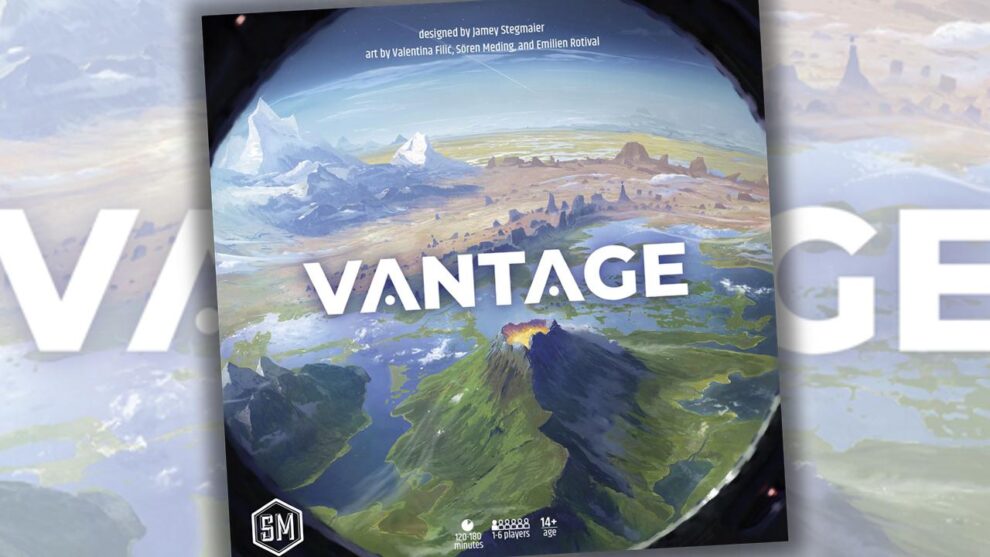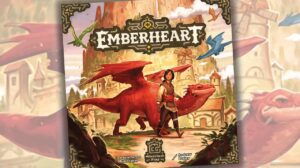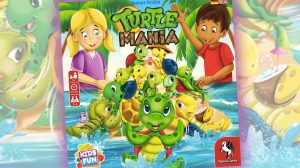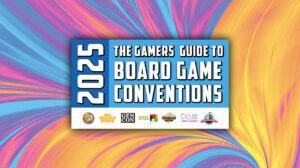Disclosure: Meeple Mountain received a free copy of this product in exchange for an honest, unbiased review. This review is not intended to be an endorsement.
I’m not really a fan of narrative games. Or maybe I should say that I don’t get many narrative games to the table, because I would love to play more story-driven games if I had the right groups. Ultimately, I haven’t tried to seek out such groups, I think in part because I don’t expect to love games in this category.
I’m not really a fan of games with a lot of status checks. “Justin enters a darkened corridor,” the tome begins. “Roll three dice to test his PERCEPTION skill. On a success, read page 1,422.” And I really hate it when there’s a lot of text to read.
I’m also not really a fan of many of the recent games in the Stonemaier Games catalog. No major negatives, but nothing that I found the need to consistently table. The ___span games have all been fine, Rolling Realms offered a nice diversion, Stamp Swap was OK. I think Scythe is still my favorite Stonemaier game, but that hit the market almost 10 years ago.
For a lot of reasons, I was hesitant to raise my hand to cover the game Vantage. It is a narrative sandbox experience for 1-6 players, with nine different storybook manuals that need to be referenced during play. Almost every turn requires players to roll dice to resolve a status check, albeit with a minor twist that I’ll detail below. The kicker: Vantage was designed by Jamey Stegmaier (the man who gave us Scythe) and published by Stonemaier Games.
Despite all the upfront baggage…I was wrong. I want to call this out, loud and clear: I was wrong. I was wrong about everything. I should have never come in with those pre-conceived notions of what “works” for me, because despite my baggage, I played Vantage six times across three days with my review group, my family, and solo. (There are six characters in the game, so I did one play with each of those characters.)
I’ve covered more than 100 games in 2025…and Vantage is my favorite game of the year.
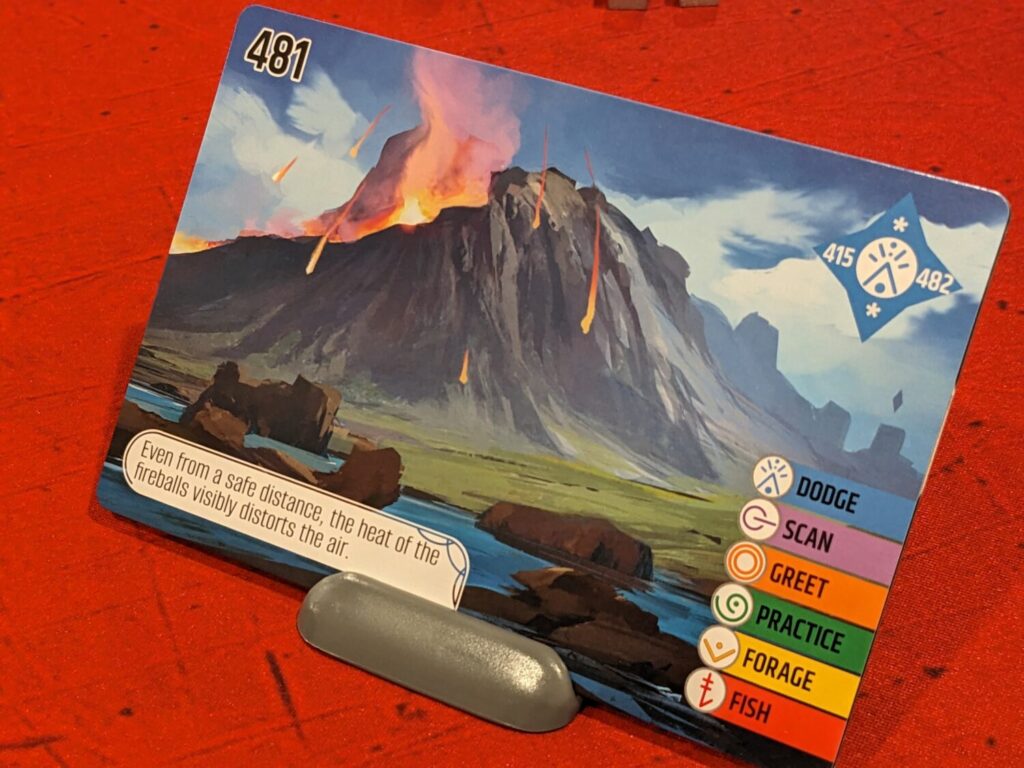
Dice, More Dice, Then a Bunch of World Building
If you follow tabletop news, you’ve probably heard of Vantage, which has become the 2025 version of Arcs, last year’s signature tabletop hobbyist news item. Vantage comes with a couple thousand cards and drops players onto a planet in the search of…well, something. Over a series of turns, players will operate one of the included characters as they navigate the planet where everyone crash landed in separate locations to start the game.
Players will then interact with sentient life forms, make decisions based on very limited information, and roll dice to satisfy conditional checks like moving between locations, fighting monsters, crafting items, and facing other open-world concepts that will be familiar to anyone who has played a “sandbox”-style video game in the last 30 years. (Think Grand Theft Auto or Fallout or Minecraft or Horizon Zero Dawn or any of the most recent The Legend of Zelda titles.)
There’s a lot more to Vantage than what I am telling you. So much more, in fact. But, at this point in the review, I have to get vague. That’s because a large portion of my love affair with Vantage is tied to surprise.
I’m a movie junkie, which, yes, means I am a man of a certain age. I like to go to movie theaters and sit, mostly alone, in a multiplex staring up at the same films most friends like to view in the comfort of their own homes. When I was a kid, I loved trailers, because I loved the tease of a good preview before the discovery of what a movie was really about during the film’s running time. Nowadays, movies have been murdered by their own marketing campaigns, so I do my best to skip trailers and show up only for the actual movie when I venture out into the world. (One movie recently broke tradition with this trend: Weapons, which thankfully leaves its most delicious spoilers out of its trailer.)
With that as our frame, I’m not going to spoil anything that I have seen so far in Vantage. But, I will broadly discuss why the game works.
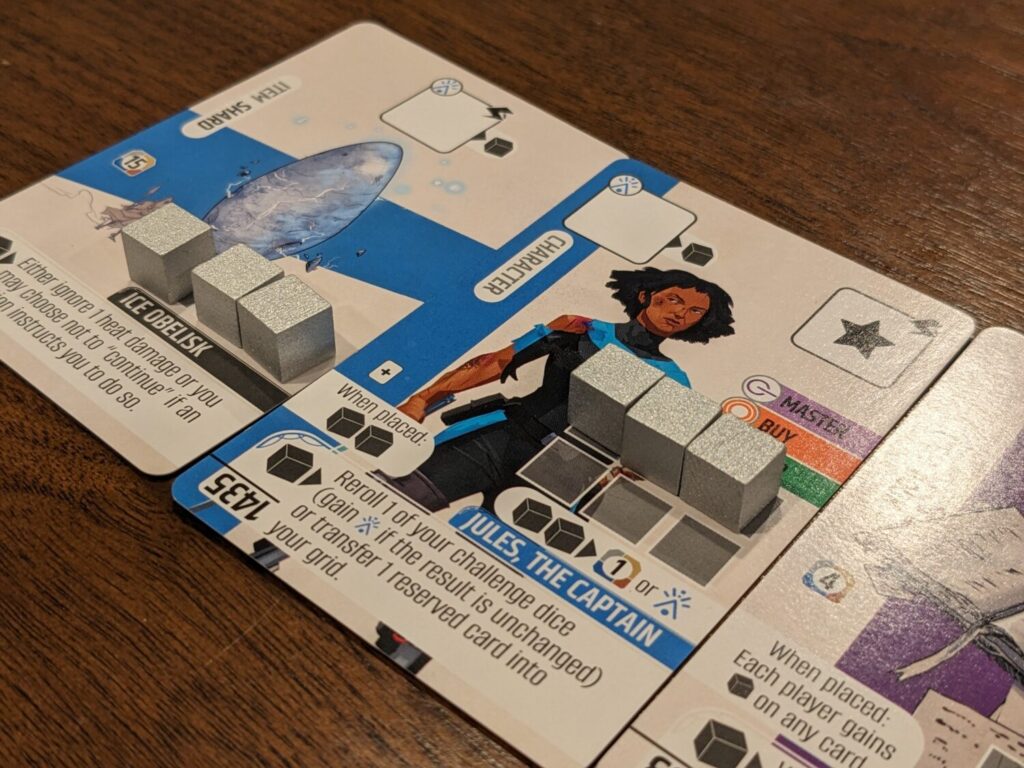
Vantage is a cooperative narrative experience, and it might be the new market leader in the inverted ratio of the number of words in its nine storybooks and journals to the amount of mental imagery it creates with its storytelling. The game’s efficient use of words to describe just enough of a scene to create a grand image of what is happening is a true achievement.
On many of the game’s turns, a player will visit a new location, represented by a horizontal, tarot-sized card showing pictures of where that player currently is; their “vantage” point, which can only be described verbally to other players. Some of the text passages on these location cards are so short they don’t give any hint at all to what’s really going on.
This is a good thing, because it requires players to get creative to share what they are seeing. The same is true of the passages in each story booklet, when a player picks from one of up to six actions on each location card. A player will read a passage from one of the booklets, and get a brief prompt: “STEAL an item. Roll four challenge dice.” Often, it’s not even clear what is possibly being stolen. In other cases—CRAFT, BUILD—it’s also not clear what is necessarily being turned into a product.
A player will chuck challenge dice then meter out the results…but in Vantage, every action is always successful. Negative dice effects are mainly tied to thematic rounding; you succeeded but it took you longer than you had hoped. Or, the action was harder than you expected, so your morale took a hit. Or maybe you stubbed your toe, lowering your total health.
Just this concept—every action is always successful—changed my entire approach to the Vantage experience. I loved this. Everything is risk-reward, but I am definitely going to get whatever it is I was trying to get. (Well, as long as my character doesn’t die on the way.) And even when the rest of a passage is read to the active player, that player doesn’t always get a firm idea of what they just did.
But you’ll have a very definitive sense of what you just got. And this is where Vantage—which was already a blast to me—reached the summit. The “stuff getting” in Vantage is leading the league. I love the action system in games like Gloomhaven but I hate the stuff getting in Gloomhaven, because as a loot system, I don’t like it. In Vantage, getting items is why I almost don’t want to finish this review, because the game’s pull is sucking me away from my laptop and I want to immediately run it back to see what kinds of stuff I’m going to get on my next run.
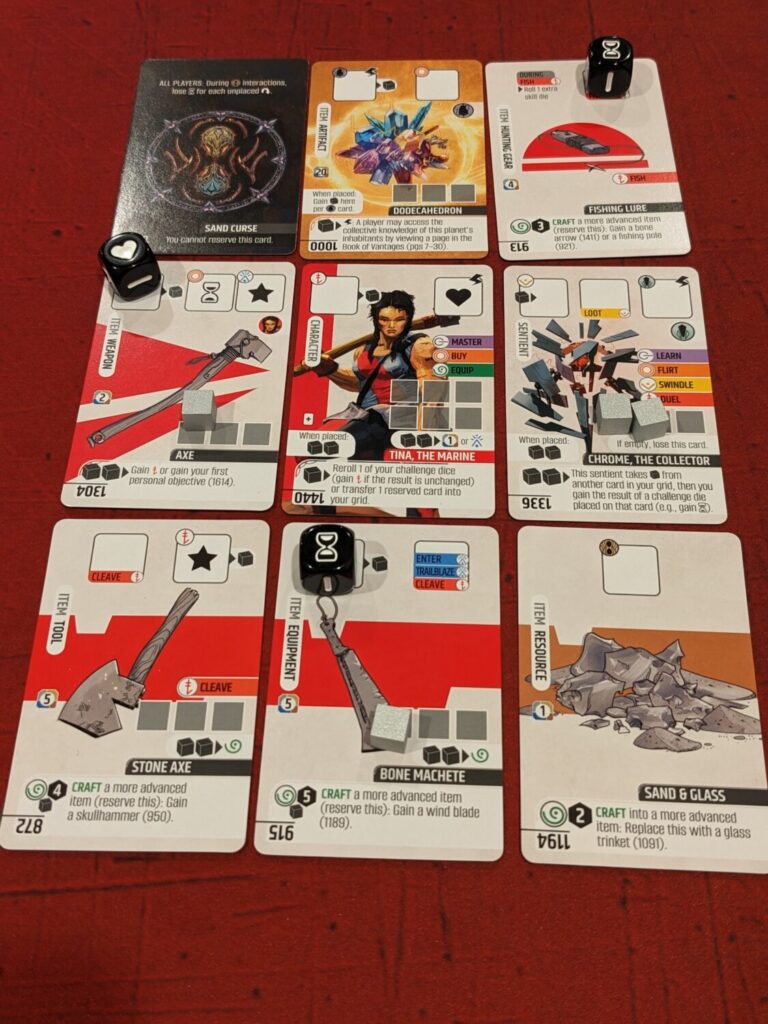
It’s All About the 3×3
Each player in Vantage gets a character. In component form, that character is a poker-sized card with a name, some artwork, and space to hold dice and boost markers. Boosts are spendable resources that can be used to help move characters around the game world or allow for a re-roll; standard stuff. But each character card has a small list of other actions that can be taken in place of a location action on a turn.
The character cards are the central card in a grid that can grow to hold as many as nine cards in a tic-tac-toe formation. (The character card takes up the middle space in the grid.) As one navigates the world, they can get a lot of other cards, representing a lot of other things—items, vehicles, other characters. The main function of these cards is to serve as a series of dice placement locations, because rolled challenge dice that are not a miss must be placed on a space in order to avoid their negative effects. The best cards have the most flexible die placement rules, along with other powers as well as card actions available for the owner.
There are almost 900 cards that can be placed into a player’s 3×3 grid. Through six games, I still haven’t seen the same card twice, and there’s a chance that I play this game 20 or 30 times and never see any duplicates.
Oh my goodness, this game has depth!
I won’t spoil any cards, but I will say that it has been fun to explore a number of different paths to build up my character in each game. In my first few games, I tried to take different types of actions every turn, regardless of the color. In other games, I leaned hard into using, say, the red military character to find other ways to acquire red cards, which typically lean into more aggressive pursuits. In some games, I tried my best to find more “destiny” cards, and in others, I hoped to find more cards with other card actions listed.
Then my pursuit of exploration went sideways. I spent my last two games completely disregarding active missions, and pursued side missions, or I simply went north every turn while taking green actions whenever I could. I leaned as hard into the word “sandbox” as possible, which reminded me of video game sessions where I would start up The Witcher 3 and only do side quests for hours on end.
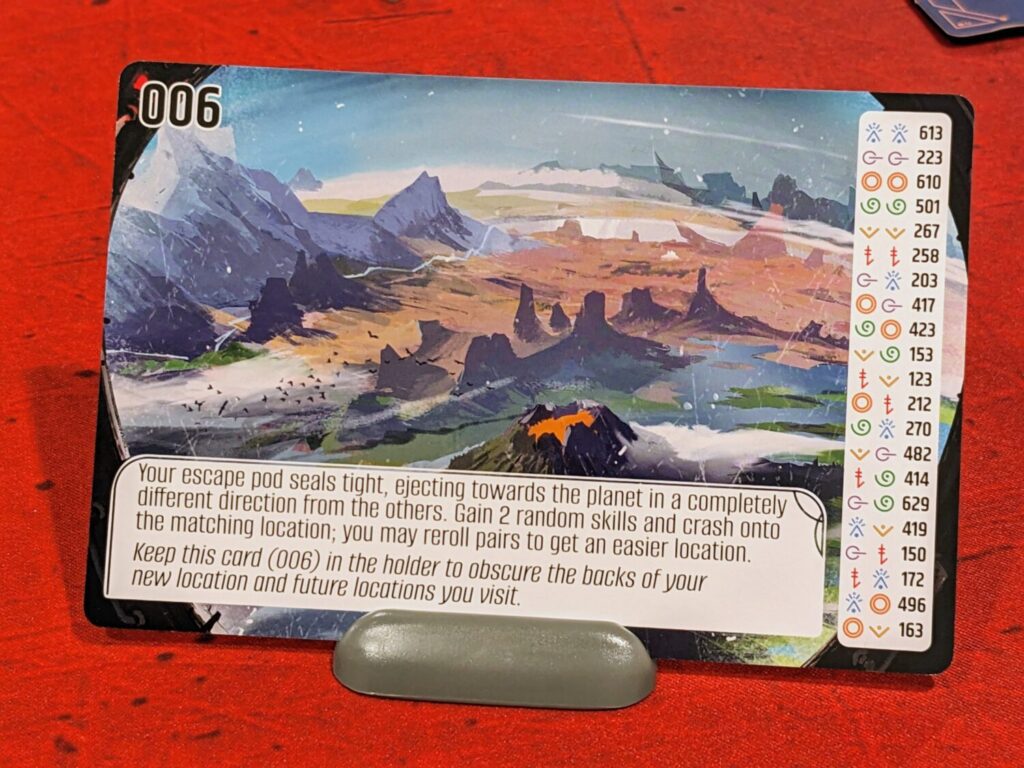
The Magic Moment
On the night that I showed this to my review crew, my friends Eric and Kev (yes, that Kevin) joined me for a three-player game. The first game went OK, and we got more familiar with the game’s systems before one of our character’s health markers hit zero. We decided to run it back and do a second play, each taking on a different character and trying our best to learn from our mistakes.
About halfway through that second game, all of us were rolling. Kev got items on his first two turns. Eric got caught up in a side quest that, even by the end, we were still laughing about (and I wouldn’t dare spoil in this review). I found myself leaning hard into green-themed everything: taking whatever green action was on each card, helping other players who needed assistance with green status checks, and running as far as possible from an environmental element I discovered on one of the cards near my starting location.
But then it happened. I finished my turn at a location, then Kev took his turn…and moved, by chance, into the exact same location as my character’s current locale.
“Wait…we are in the same location?” I squealed.
“Yep,” Kev said. I can’t remember if we immediately gave each other a high-five or if I stood up and gave him a bear hug. It doesn’t matter, because in a game with nearly 800 different locations, we were on the exact same one, by complete chance, and we were going to do our best to enjoy the moment.
And that play could not have gotten more exciting than it was for me over the next 45 minutes.
Kev and I raided a building together. We shared resources, and swapped goodies. We made small talk, and did a special activity together. We found an item that allowed us to travel a little faster, obviously together. In many ways, Eric felt like the third wheel on date night at the local extraterrestrial planet just by continuing to sit at the table. The game’s rules dictate that when players are at the same location, it’s the only time when you can look at the card of another player, and it’s the only time when players can travel as if they are one entity.
In a year of great gaming moments, this 45-minute ridealong session might have been my favorite thrill ride of them all. “Hey, where should we go next?” one of us would start. “Nah, I’m good on items, you keep it,” one person offered after getting a particular item later on. “Hey, maybe you do that one thing, then I’ll do that other thing on my turn?” one of us suggested.
And I’m not even telling you what Kev and I did during our time together! Vantage has so many moments, so many things that bring me back to my new love affair for the experience…because it is just that good.
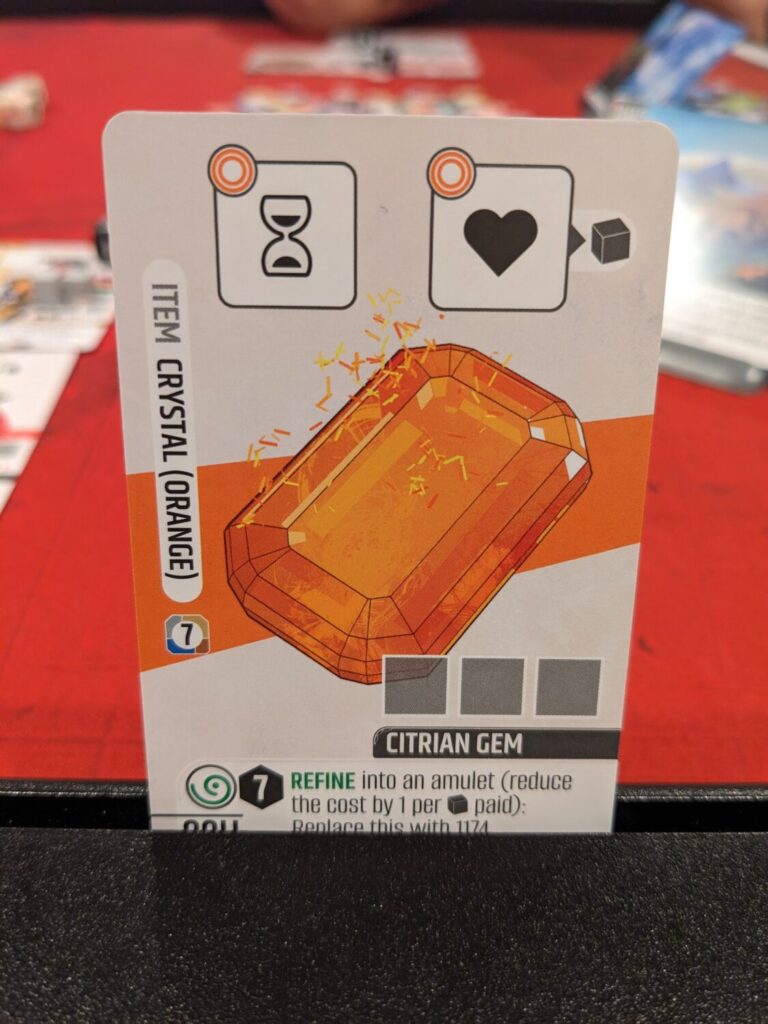
Finish the Review, Then Buy a Copy
Vantage is a triumph. I know that because it is very openly a game I should not like, and not only do I like it, I love it. It is currently living on my dining room table, begging to be played by anyone within earshot.
It’s a fully cooperative game that I think gets better with more players, because of the way dice are allocated during status checks…but Vantage suffered a major hit to my level of enjoyment when I tried it with my family.
That was a four-player game. Even 15 minutes into the game, my 11-year-old was visibly tired of watching other players take turns. This was especially true for one sequence where my eight-year-old took a turn, then got a bonus turn, then my wife had a turn, and she also got a bonus turn. And those four turns, plus my turn, were longer than normal. The 11-year-old was squirming by the time their wait was over.
This made my family play the first and last time I will try the game with more than three players. Vantage plays up to six players, and there ain’t no way I’m doing this at six. I had a lot of fun with the solo mode, but because of the shared experience, I think this will live on as a two, maybe three-player game moving forward.
The game’s main barrier to entry is the sheer level of maintenance required to manage each play. While there is not that much reading, turn to turn, there is a ton of card cycling. On most turns, a player will get a new location card, take one action there, then move to a new location on their next turn. Someone’s got to manage the distribution of those cards. There is a constant need to grab a card from its place in the box, and finding that card takes a moment each time something new needs to be fished from its home. (Remember, there are 800+ location cards and 900+ other cards.)
Across three or four players, across 20, 30, 50 turns, that can be a lot. I began to notice this in my fourth and fifth plays, especially with the three player games. The time this requires is not gamebreaking but it’s worth a call out, especially if you are playing alone and move from taking a turn to reading the text in the fourth journal to fishing out a location card and an item card before taking your next turn.
Otherwise, I don’t have any notes regarding my play experience with Vantage. Near the back of the main rulebook, Stegmaier highlights the long journey Vantage took to get into our hands, across an eight-year development and production cycle with little things like needing illustrations to populate 1,700 different cards. All of it shows in the final product, a game that mirrors my feelings about productions like The Elder Scrolls: Betrayal of the Second Era, epic undertakings that might be the only game a player needs for the entire year.
Vantage has taken the place of Scythe as my favorite Stonemaier product, and for good reason. I think of it as a game that is truly for everyone, an exceptional experience in a landscape where most games aim to simply iterate upon recent success to build something new. Vantage stands alone thanks to many years of building a world that begs to be seen from every angle.


